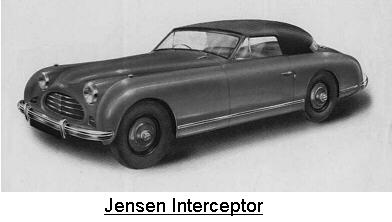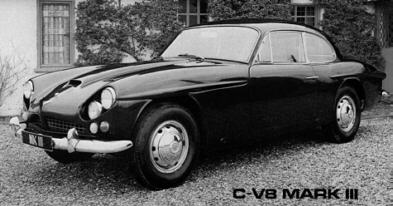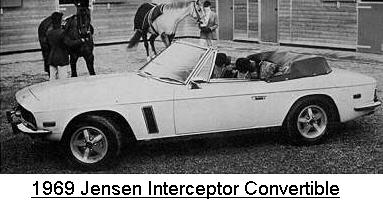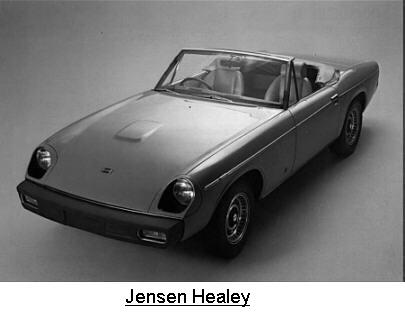
The Jensen - Austin - Healey Connection

Like most of us I can remember quite vividly
when I bought my first Austin-Healey. It was April 1972 and the 100 sure
looked wonderful in the car sales yard. I had previously owned a series
of Minis so was no newcomer to English designed cars. Needless to say I
was looking forward to driving my new car under the Australian sun but
had no idea that it would spark off another interest that was lurking inside
of me.  I
wasn’t the slightest bit interested in history while at school but before
long I had an insatiable interest in the history of my favourite marque
which grew into wanting to know more about the Donald Healey Motor Company
(DHMC), the English automotive industry then the Australian and now the
massive US industry. Snippets of information are fascinating, such as the
a coachbuilding company established in New York called Healey bodies before
World War One. I have also become interested in the First World War and
just recently in the naval battles of the American Civil War. Living in
the antipodes, it is not a subject heard of frequently. Woops! I am digressing
away from what I wanted to explore with this little missive, being the
connection between the Jensen brothers, Austin Motor Company, the DHMC
and Donald Mitchell Healey.
I
wasn’t the slightest bit interested in history while at school but before
long I had an insatiable interest in the history of my favourite marque
which grew into wanting to know more about the Donald Healey Motor Company
(DHMC), the English automotive industry then the Australian and now the
massive US industry. Snippets of information are fascinating, such as the
a coachbuilding company established in New York called Healey bodies before
World War One. I have also become interested in the First World War and
just recently in the naval battles of the American Civil War. Living in
the antipodes, it is not a subject heard of frequently. Woops! I am digressing
away from what I wanted to explore with this little missive, being the
connection between the Jensen brothers, Austin Motor Company, the DHMC
and Donald Mitchell Healey.
Not long into my ownership of my 100 I was
fairly surprised to find out that the car, being half labelled an Austin
wasn’t built by them at all, except for the assembly of Austin mechanical
components right at the end of its construction. I found it interesting
that the chassis were supplied by a company called John Thompson Motor
Pressings and the bodies supplied, assembled and trimmed by the Jensen
Motor Company. I was later to find out that while the connection with the
DHMC may have started in 1952 the association with Austin went back a lot
further.
Early Days
Alan and Richard Jensen produced their first
car in 1928 when they converted a five year old Austin 7 Chummy Saloon
into a very stylish two seater with cycle guards, louvred bonnet and boat-tail.
This was soon sold and replaced with another Austin 7. Then came a car
produced on a Standard chassis followed by a series of specials based on
the Wolseley Hornet, a popular sporting small car of the time. The early
1930s saw the brothers becoming joint managing directors of commercial
coachbuilders W J Smith & Sons and within three years the name of the
company was changed to Jensen Motors Limited. Soon bodywork conversions
followed on readily available chassis from Morris, Singer, Standard and
Wolseley.
Jensen’s work did not go unnoticed as they
received a commission from actor Clark Gable to produced a car on a US
Ford V8 chassis. This stylish car led to an arrangement with Edsel Ford
for the production of a range of sports cars using a Jensen designed chassis
and powered by Ford V8 engines equipped with three speed Ford transmissions.  Next
came a series of sporting cars powered by the twin-ignition straight eight
Nash engine or the Lincoln V12 unit. On the commercial side of the business
Jensen’s were the leaders in the field of high-strength light alloys in
commercial vehicles and besides buses also produced a range of alloy bodied
trucks powered by either Ford V8s, fours or Perkins diesels.
Next
came a series of sporting cars powered by the twin-ignition straight eight
Nash engine or the Lincoln V12 unit. On the commercial side of the business
Jensen’s were the leaders in the field of high-strength light alloys in
commercial vehicles and besides buses also produced a range of alloy bodied
trucks powered by either Ford V8s, fours or Perkins diesels.
World War Two saw sports car production put aside with attentions turned to more appropriate activities such as revolving tank gun turrets, explosives and converting the Sherman Tank for amphibious use in the D-Day invasion of Europe.
Post-War and Austin
August 1946 saw Jensen launch their entirely
new ‘PW’ model powered by a Meadows straight eight of 3,860cc and was shown
with some success in the London Motor Show of the same year. Unfortunately
the Meadows engine suffered from excessive vibration and Jensen had to
fall back on a stock pile of pre-war Nash engines. Not long after Richard
Jensen saw what looked like another ‘PW’ on the streets of London, however
it turned out to be a new four litre Austin Sheerline. What happen was
that Leonard Lord of Austin (soon to feature largely in the decision to
produce the Austin-Healey) had also seen the ‘PW’ at the show and set into
production the similar looking Sheerline. A meeting was held between Lord
and the somewhat aggrieved Richard Jensen. In an effort to placate Jensen,
Lord offered the use of the Austin four litre six cylinder. Jensen really
couldn’t refuse, as the ‘PW’ was a car looking for an engine. This arrangement
was to lead to an association between the companies that was to last for
over twenty years.
The Austin 4 litre is of interest to Austin-Healey
owners. Its capacity is 3,993cc from a bore and stroke of 87.3mm by 111.1mm
and if that sounds familiar, it is also the dimensions as the Austin-Healey
100 engine. What that means of course is that the engine is the six cylinder
version of the four.
With the availability of an engine assured,
the Jensen brothers once again turned their minds towards the production
of another sporting car. Designer Eric Neale suggested using a propriety
chassis, so a further approach was made to Leonard Lord for Austin to supply
their A70 chassis. Lord readily agreed with the proviso that Jensen also
produce a special sports body for the Austin A40. The resulting two vehicles
ended up looking quite similar in style. The name Interceptor was chosen
for the Jensen model, a name that was to be used again some years later.
The smaller vehicle was titled the Austin A40 Sports and some 3,200 were
produced with 643 exported to the US.
The production of the A40 Sports provided
Jensen’s with a steady stream of income allowing the company to design
and produce their own vehicles such as the Interceptor. It also allowed
the company to bid for other projects such as the production of the new
Austin-Healey 100. In the April/May 1998 issue of the Austin-Healey Magazine
I told the story how at the 1952 London Motor Show at Earl’s Court, Leonard
Lord did not quite come across the new Healey 100 by accident. Lord had
set up an unofficial competition between Jensen, Healey and Fraser-Nash.
The Jensen vehicle was a very pretty two door open sports car that had
been commissioned by Lord to be built on the A40 chassis. Unfortunately
the Jensen wasn’t finished in time for the Motor Show so it wasn’t available
for Lord to see.
You would have thought that the deal between
Leonard Lord and Donald Healey would have meant that Austin would manufacture
the new Austin-Healey 100. No, not quite as Austin, like the DHMC did not
have the capacity to produce the car from scratch in the volume desired.
However DMH had close contact with Tickford (now owned by Ford) and preliminary
discussions had revealed that production of around 40 cars per week could
be achieved. On hearing of the new Austin-Healey a meeting was also arranged
between Lord and Richard Jensen, where Lord was advised that Jensen could
produce 150 cars per week. Lord was interested but wanted to see the Jensen
prototype A40 based sports car as an example of their work. History tells
us that Lord was impressed with the vehicle and the contract to build the
bodies of the New Austin-Healey was awarded to the Jensen Motor Company.
From that point all subsequent styling and body engineering on the big
Healey including competition vehicles was undertaken by Jensen in conjunction
with the DHMC.
Again with a steady stream of income assured,
Jensen could develop an all new GT car as a successor to the Interceptor.
This vehicle turned out to be the Jensen 541, so named as it was released
for sale in 1954. A Jensen designed chassis was used for the 541 but still
with the Austin drivetrain and A70 suspension. In my opinion the 541 was
the most attractive coupes of the 1950s and I suspect that it was also
a favourite of DMH as he took delivery of one example but without an engine.
A small block Chevrolet V8 was fitted at the DHMC and it became a very
fast and safe transport for him. Safe? Yes the 541 was the first British
production saloon car to be fitted with four wheel disc brakes.While Jensen
continued to construct the Austin-Healey they drifted away from using Austin
components for their own vehicles. The next Jensen launched was in 1962
and titled the CV8, which as the name implies was powered by a V8 engine
supplied by Chrysler complete with their excellent Torqueflite automatic
transmission. The
same powertrain was also fitted to the Italian styled Jensen Interceptor
range introduced in 1966 and stayed in production until 1975.
The
same powertrain was also fitted to the Italian styled Jensen Interceptor
range introduced in 1966 and stayed in production until 1975.
Other Contract and Projects
The Jensen Motor Company was not immune to
the world of corporate takeovers and suffered that fate at the hands of
the Norcross Group in the late 1950s. A step that would eventually lead
to the premature retirement of Alan and Richard Jensen. However this was
not before Jensen’s won a contract to assemble, paint and finish the new
Volvo P1800 coupe on bodies produced by Pressed Steel in Scotland. The
completed bodies were then shipped to Sweden for the addition of mechanicals.
The arrangement wasn’t wholly satisfying as the Pressed Steel shells weren’t
to a high standard plus the cars were arriving in Sweden with a fair amount
of damage. Some 130 bodies were being completed per week until Volvo paid
out the contract and commenced to finish the vehicles themselves.
Also for 5 ½ years during the 1960s
Jensen built 7,067 Sunbeam Tigers for the Roots Group until such a time
when Roots was taken over by Chrysler, who couldn’t countenance a Ford
V8 in one of their cars.
While they weren’t the first, Jensen also
during the late 1960s and 70s produced the highly successful Jensen FF
models. The letters stood for Ferguson Formula and was in essence four
wheel drive through a transfer case. The same cars were also fitted with
the Dunlop Maxaret breaking system which prevented brake lock-up by the
use of mechanical sensors. Yes it was all many years before today’s 4WD
sedans and ABS breaking.
However it was the Austin-Healey contract
that was the main source of income for the Jensen Motor Company. It was
also common knowledge in 1965 that Donald Healey was at loggerheads with
George Harriman of BMC over the DHMC financial cut from big Healey manufacturing.
It was Harriman’s intention to wind up Healey production and replace it
with a badge-engineered MG model. (This turned out to be the MGC which
was also to be sold as the Austin-Healey 3000 Mk IV) As a result of all
this the Jensen brothers decided to build a new model to replace the Austin-Healey
in the US market. Two prototypes were built and called the P66. One car
was tested by Autocar magazine who found that it was powered a 4.5 litre
Chrysler V8 making it good for 140 mph. This new car was destined for the
US market, and was undoubtedly British plus it had the familiarity of the
home-grown V8. Unfortunately the P66 caused insurmountable ructions within
the company and the Norcross Group. The Jensen Brothers saw the car as
the natural successor to the Austin-Healey 3000 which the other side wanted
a replacement for the CV8. The P66 was priced at 2,200 Pounds in the UK
against 3,500 Pounds for the CV8.  Understandably
the Norcross Group won as they controlled the purse strings and the P66
project was abandoned for the well known Jensen Interceptor. Within weeks
Eric Neale, the chief designer had resigned and both Alan and Richard Jensen
retired. Jensen was no longer a family company.
Understandably
the Norcross Group won as they controlled the purse strings and the P66
project was abandoned for the well known Jensen Interceptor. Within weeks
Eric Neale, the chief designer had resigned and both Alan and Richard Jensen
retired. Jensen was no longer a family company.
The Jensen-Healey
The late 1960s saw the Jensen Motor Company
in a dire financial situation as the Austin-Healey contract had come to
an end and there were build problems with the Interceptor. Norcross sold
the company to merchant bankers William Brandt. Sons & Company Ltd.
And through careful management Interceptor production increased in an effort
to improve sales and then decreased to improve construction standards.
Jensen was a company going nowhere. However all was not lost as DMH once
again entered the scene as he had been discussing the production of a new
sports car with Mr Kjell Qvale, a San Franciscan businessman. Qvale operated
a very successful business selling Jaguar, Rolls-Royce and BMC vehicles. He too was dismayed at the discontinuing of the Austin-Healey 3000 and
like a lot of us many years later, was surprised at the role played by
Jensen in the construction of the big Healey, and yes he was interested
in the ideas of DMH for a new sports car. Before long Qvale became Jensen’s
majority shareholder and assumed full control of the company with DMH as
Chairman and Geoff Healey one of the company directors. Additionally with
DMH as Chairman of Jensen meant that the DHMC lost their valuable British
Leyland Motor Corporation franchise and US Forces concession as well. The
DHMC quickly negotiated a franchise with Fiat.
He too was dismayed at the discontinuing of the Austin-Healey 3000 and
like a lot of us many years later, was surprised at the role played by
Jensen in the construction of the big Healey, and yes he was interested
in the ideas of DMH for a new sports car. Before long Qvale became Jensen’s
majority shareholder and assumed full control of the company with DMH as
Chairman and Geoff Healey one of the company directors. Additionally with
DMH as Chairman of Jensen meant that the DHMC lost their valuable British
Leyland Motor Corporation franchise and US Forces concession as well. The
DHMC quickly negotiated a franchise with Fiat.
The story of the Jensen-Healey is one of building
a car that was almost right, but problems with build quality and engine
reliability were to thwart it from the beginning. First a Vauxhall engine
and then one from BMW were considered before an untried and undeveloped
Lotus unit was used. Sure it satisfied the all important US emission regulations
and as it was designed to be fitted at an angle of 45 degrees it was not
unduly tall but Qvale was insistent on early delivery, way before it was
ready. The vehicle made its debut at the Geneva Motor Show in March 1972
with initial press approval. It wasn’t long before the faults of the car
rose to the surface and to be fair to Lotus, Colin Chapman did warn Qvale
that the engine was underdeveloped. In the end it was the customers who
developed the engine and car by their own use and rectification cost Jensen
more money then it could afford.
The Mk2 when released in August 1973 was a
vastly improved car and was improved again with the use of the German Getrag
five-speed gearbox in November 1974. However DMH became disgruntled with
the whole arrangement and left the Jensen Board in 1974 and refused to
have his name associated with the fixed-head, hatch-back GT version introduced
in July 1975.
The connection with Austin had long been severed
and so had that with DMH. Jensen lurched from crisis to crisis and the
"energy crisis" of 1974 brought on by the Yom Kippur War resulted in the
company being at the brink of collapse. A plea to the left wing British
Government of the time fell on deaf ears and Jensen Motors Ltd ceased trading
in May 1976. Qvale purchased the Jensen assets from the Receiver and went
on to form a company that serviced and renovated Jensen vehicles, but derived
its main income from the importing and distribution of Subaru and Hyundai
cars.
For the sake of the record there have been
attempts to recreate the Jensen Interceptor and the special place held
by the cars of the marque. However each have met with varying degrees of
success and as there has been no Austin or Healey involvement it is as
they say, another story.
Happy Healeying
Email
Patrick Quinn
Sydney, Australia
Image Credits.
Tony
Baileys Jensen Brochure Homepage
The Illustrated Encyclopedia of the Worlds Automobiles